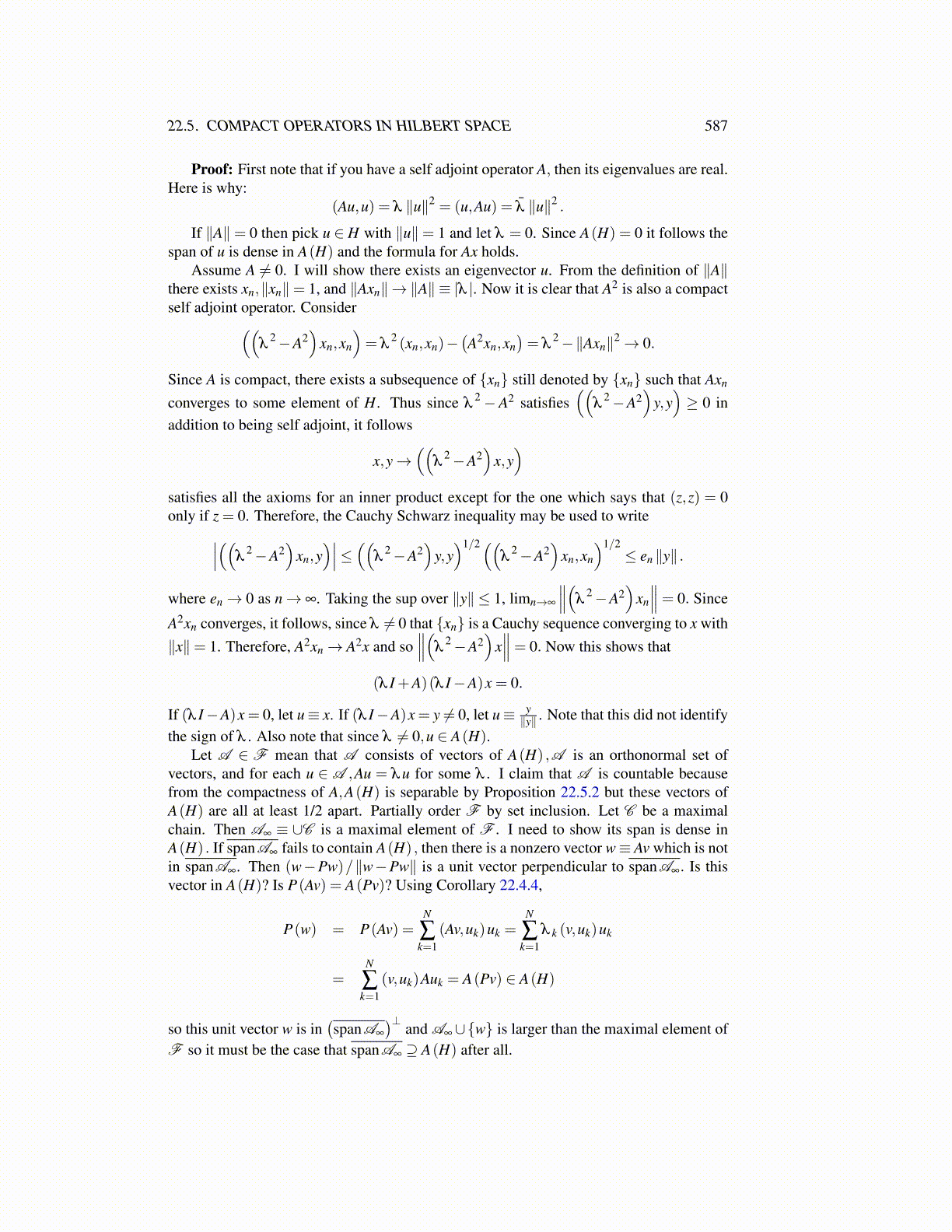
22.5. COMPACT OPERATORS IN HILBERT SPACE 587
Proof: First note that if you have a self adjoint operator A, then its eigenvalues are real.Here is why:
(Au,u) = λ ∥u∥2 = (u,Au) = λ̄ ∥u∥2 .
If ∥A∥= 0 then pick u ∈ H with ∥u∥= 1 and let λ = 0. Since A(H) = 0 it follows thespan of u is dense in A(H) and the formula for Ax holds.
Assume A ̸= 0. I will show there exists an eigenvector u. From the definition of ∥A∥there exists xn,∥xn∥= 1, and ∥Axn∥→ ∥A∥ ≡ |λ |. Now it is clear that A2 is also a compactself adjoint operator. Consider((
λ2−A2
)xn,xn
)= λ
2 (xn,xn)−(A2xn,xn
)= λ
2−∥Axn∥2→ 0.
Since A is compact, there exists a subsequence of {xn} still denoted by {xn} such that Axn
converges to some element of H. Thus since λ2−A2 satisfies
((λ
2−A2)
y,y)≥ 0 in
addition to being self adjoint, it follows
x,y→((
λ2−A2
)x,y)
satisfies all the axioms for an inner product except for the one which says that (z,z) = 0only if z = 0. Therefore, the Cauchy Schwarz inequality may be used to write∣∣∣((λ
2−A2)
xn,y)∣∣∣≤ ((λ
2−A2)
y,y)1/2((
λ2−A2
)xn,xn
)1/2≤ en ∥y∥ .
where en→ 0 as n→ ∞. Taking the sup over ∥y∥ ≤ 1, limn→∞
∥∥∥(λ2−A2
)xn
∥∥∥= 0. Since
A2xn converges, it follows, since λ ̸= 0 that {xn} is a Cauchy sequence converging to x with∥x∥= 1. Therefore, A2xn→ A2x and so
∥∥∥(λ2−A2
)x∥∥∥= 0. Now this shows that
(λ I +A)(λ I−A)x = 0.
If (λ I−A)x = 0, let u≡ x. If (λ I−A)x = y ̸= 0, let u≡ y∥y∥ . Note that this did not identify
the sign of λ . Also note that since λ ̸= 0,u ∈ A(H).Let A ∈ F mean that A consists of vectors of A(H) ,A is an orthonormal set of
vectors, and for each u ∈ A ,Au = λu for some λ . I claim that A is countable becausefrom the compactness of A,A(H) is separable by Proposition 22.5.2 but these vectors ofA(H) are all at least 1/2 apart. Partially order F by set inclusion. Let C be a maximalchain. Then A∞ ≡ ∪C is a maximal element of F . I need to show its span is dense inA(H) . If spanA∞ fails to contain A(H) , then there is a nonzero vector w≡ Av which is notin spanA∞. Then (w−Pw)/∥w−Pw∥ is a unit vector perpendicular to spanA∞. Is thisvector in A(H)? Is P(Av) = A(Pv)? Using Corollary 22.4.4,
P(w) = P(Av) =N
∑k=1
(Av,uk)uk =N
∑k=1
λ k (v,uk)uk
=N
∑k=1
(v,uk)Auk = A(Pv) ∈ A(H)
so this unit vector w is in(spanA∞
)⊥and A∞∪{w} is larger than the maximal element of
F so it must be the case that spanA∞ ⊇ A(H) after all.